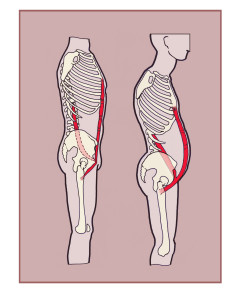 The psoas major and the rectus abdominis muscles have an important relationship inside the body even though they don’t literally work together.
The psoas major and the rectus abdominis muscles have an important relationship inside the body even though they don’t literally work together.
Muscles relate to each other in many different ways.
Sometimes they work in opposition—for the hamstring to lengthen the quadriceps must shorten.
This happens through the process of reciprocal inhibition and most often occurs in muscles that live on opposite sides of a bone.
Muscles are not elastic and therefore cannot naturally retract after stretching.
Muscles also work synergistically—they help the opposite pairs fulfill their function when needed.
The tensor fascia latae synergistically helps the psoas major with hip flexion and internal rotation.
Other muscles work together though they aren’t literally connected- the levator ani (pelvic floor) and the diaphragm should do the same thing at the same time to achieve optimal function.
Some of these relationships are clear-cut like the hamstring and quadriceps, but others like the psoas major and rectus abdominis are more complicated.
The Psoas Major and the Abdominal Contents
The contents of the trunk, below the ribcage, and above the pelvis are suspended within a “box” of muscles.
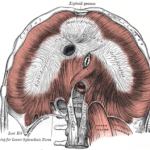
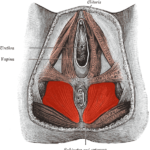
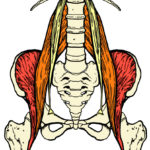
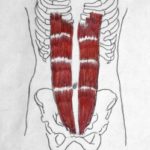
The diaphragm and the levator ani are at the top and bottom of the box, and the psoas major and the rectus abdominis at the back and front of the box.
The abdominal contents include the intestines, the liver, the bladder, and the kidneys.
The tone of the muscles that box the organs in can have a major impact on the way the organs function.
I’ve written before about lower back pain and the rectus abdominus.
Sit-ups are not the answer for back pain though they are often recommended.
Too many sit-ups or an overdeveloped rectus abdominis can also be a problem when we have a tight psoas major.
A long and happy psoas major muscle lives deep in the bowl of the pelvis creating a sort of shelf alongside the curve of the sacrum.
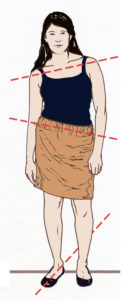 A tight psoas major is pulled forward from the back of the pelvis and basically loses its curve and shelf-like qualities.
A tight psoas major is pulled forward from the back of the pelvis and basically loses its curve and shelf-like qualities.
When this happens the abdominal contents are thrust forward as well and in extreme cases, the belly is pushed out.
But the belly can only be pushed out if the rectus abdominis is soft enough to allow this forward thrust.
If the rectus abdominis is tight from too many sit-ups or crunches, it will have no room to accommodate the organs that are being pushed forward.
This environment—tight psoas major and tight rectus abdominis— can have a tremendous effect on digestion, breathing, menstruation and more.
If the psoas major and the rectus abdominis have their proper tone the abdominal contents can live happily within the bowl of the pelvis and below the ribcage.
Creating good tone in the abdominal “box” would go a long way towards a finely tuned body but there are many factors working against us.
A tight psoas major most often needs to be released rather than stretched and the tone of the rectus abdominis is usually a victim of poor posture and is rarely aligned correctly.
For the psoas major and rectus abdominis to live in harmony we must find our way to better posture and movement patterns.
It can’t be done without awareness and concentration but that doesn’t mean it’s not worth the effort.
Perseverance will further.
